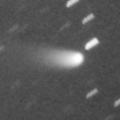
|
It is expected to be a great comet of -1 mag in 2013 spring. Appearing in the morning sky in the Southern Hemisphere. Now it is 8.0 mag (Dec. 27, Marco Goiato). Brightening as expected. In the Southern Hemisphere, it keeps observable in the low sky until mid February. In the Northern Hemisphere, it keeps unobservable for a long time until 2013 March, when the comet will appear as a 0-mag great comet.
Date(TT) R.A. (2000) Decl. Delta r Elong. m1 Best Time(A, h)
Dec. 29 17 9.58 -38 41.1 2.496 1.641 23 8.1 5:36 (309,-12)
Jan. 5 17 27.87 -40 6.6 2.332 1.519 26 7.7 5:38 (312,-11)
|
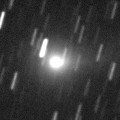
|
Long-lost comet for almost 200 years since 1827. Finally re-discovered by Rob Matson from SWAN images of mid November. It was very bright as 8.6 mag in early December (Dec. 8, Juan Jose Gonzalez). Now it is not observable. It can brighten furthermore after the perihelion passage. In the Northern Hemisphere, it will appear in the morning sky at 8-9 mag in mid January, then it keeps observable in excellent condition while fading. In the Southern Hemisphere, it must have been locating high from summer to autumn, but it has not been discovered. After this, it is only observable in low sky from February to March.
Date(TT) R.A. (2000) Decl. Delta r Elong. m1 Best Time(A, h)
Dec. 29 18 53.81 -11 21.7 1.758 0.829 12 8.1 18:27 ( 82, -8)
Jan. 5 18 49.05 -8 1.7 1.778 0.866 15 8.1 5:38 (275, -7)
|
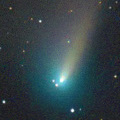
|
Now it is so bright at 9.3 mag (Dec. 23, Juan Jose Gonzalez). Very close to the earth now. However, it will go away from the earth and fade out rapidly after mid January. The condition is good in the Northern Hemisphere. It will become observable in good condition also in the Southern Hemisphere after January.
Date(TT) R.A. (2000) Decl. Delta r Elong. m1 Best Time(A, h)
Dec. 29 7 44.79 56 39.7 0.301 1.240 144 8.1 1:25 (180, 68)
Jan. 5 5 23.77 28 56.0 0.324 1.287 156 8.5 22:17 ( 0, 82)
|
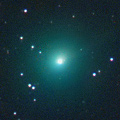
|
Getting brighter much faster than expected. Now it is so bright as 9.4 mag (Dec. 20, Chris Wyatt). It will approach to the sun down to 0.73 A.U. in 2013 March. It may brighten up to 3 mag at best. In the Southern Hemisphere, it keeps observable while brightening gradually after this in good condition. In the Northern Hemisphere, it is only observable until early January when it becomes 9 mag. After 2013 May, it keeps observable in good condition while fading gradually.
Date(TT) R.A. (2000) Decl. Delta r Elong. m1 Best Time(A, h)
Dec. 29 12 6.01 -33 42.3 1.523 1.702 82 9.6 5:35 ( 0, 21)
Jan. 5 12 12.62 -40 38.1 1.365 1.603 84 8.9 5:14 ( 0, 14)
|

|
It brightened up to 9.0 mag in 2012 autumn (Nov. 4, Juan Jose Gonzalez). It is not observable now. In the Southern Hemisphere, it will appear in the morning sky at 9 mag in 2013 February, then it keeps observable in good condition while fading slowly. In the Northern Hemisphere, it is hardly observable after 2013.
Date(TT) R.A. (2000) Decl. Delta r Elong. m1 Best Time(A, h)
Dec. 29 18 8.62 -27 9.3 2.797 1.824 6 9.1 5:36 (293,-15)
Jan. 5 18 26.87 -29 12.1 2.777 1.820 10 9.1 5:38 (296,-14)
|
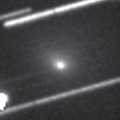
|
First return of a new periodic comet discovered in 1994. Although it had been fainter than expected, it is brightening rapidly now. Now it is so bright as 10.6 mag (Dec. 13, Katsumi Yoshimoto). It has a large diffuse coma. It It will be observable at 10 mag in excellent condition in this winter.
Date(TT) R.A. (2000) Decl. Delta r Elong. m1 Best Time(A, h)
Dec. 29 0 19.19 -7 11.2 0.992 1.323 84 11.7 18:27 ( 14, 47)
Jan. 5 0 47.16 -7 46.4 1.048 1.350 83 12.0 18:32 ( 16, 46)
|
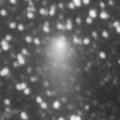
|
Now it is bright as 11.4 mag (Oct. 15, Chris Wyatt). It is expected to be observable at 11-13 mag for a long time from 2012 summer to 2013 summer. It will be getting higher gradually in the morning sky. Finally it becomes observable also in the Northern Hemisphere.
Date(TT) R.A. (2000) Decl. Delta r Elong. m1 Best Time(A, h)
Dec. 29 16 0.33 -34 15.7 2.975 2.241 34 12.4 5:36 (315, 2)
Jan. 5 16 4.96 -32 58.3 2.929 2.272 40 12.4 5:38 (318, 6)
|

|
It kept as bright as 6-7 mag for a long time from 2011 summer to 2012 spring. Now it is fading. But it is very bright and visible visually at 14.0 mag still now (Dec. 13, Sandor Szabo).
Date(TT) R.A. (2000) Decl. Delta r Elong. m1 Best Time(A, h)
Dec. 29 9 39.38 -9 35.4 4.009 4.628 123 13.2 3:09 ( 0, 45)
Jan. 5 9 32.28 -10 6.4 3.988 4.692 131 13.3 2:35 ( 0, 45)
|

|
It brightened up to 11-12 mag in 2012. It is appearing in the morning sky now. It will be observable at 12-13 mag in good condition again in 2013.
Date(TT) R.A. (2000) Decl. Delta r Elong. m1 Best Time(A, h)
Dec. 29 15 34.48 -16 57.2 6.175 5.486 42 13.3 5:36 (308, 18)
Jan. 5 15 34.95 -17 6.3 6.098 5.505 49 13.3 5:38 (313, 23)
|

|
Now it is 13.9 mag (Dec. 13, Hiroshi Abe). It is expected to brighten up to 10 mag from winter to spring in 2013. In the Northern Hemisphere, it keeps observable in good condition until 2013 April. It is not observable now in the Southern Hemisphere. It will become observable after 2013 April, but it keeps locating low.
Date(TT) R.A. (2000) Decl. Delta r Elong. m1 Best Time(A, h)
Dec. 29 23 37.73 68 30.8 1.832 2.314 106 13.5 18:27 (167, 55)
Jan. 5 0 4.81 65 10.6 1.791 2.249 104 13.3 18:32 (163, 57)
|
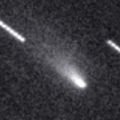
|
It brightened rapidly, and reached up to 15.1 mag in mid November (Nov. 15, Catalina Sky Survey). However, Hidetaka Sato reported that it is 15.8 mag on Dec. 6. Maybe the brightness evolution got slow down. The central condensation seems to be elongated on Jean-Francois Soulier's images on Dec. 11. It approaches to the Sun down to 0.3 A.U. in 2013 February. The ephemeris says it will brighten up to 7 mag. However, because the comet is small, it may be disintegrated. It keeps observable in good condition until February while brightening gradually.
Date(TT) R.A. (2000) Decl. Delta r Elong. m1 Best Time(A, h)
Dec. 29 1 5.34 -17 4.0 0.959 1.380 90 13.8 18:32 ( 0, 38)
Jan. 5 0 48.66 -20 21.0 0.982 1.251 79 13.4 18:32 ( 13, 34)
|
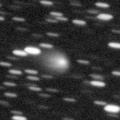
|
Now it is 13.3 mag (Nov. 15, Sandor Szabo). It keeps bright at 13-14 mag for a long time until 2014. It keeps observable for a long time in the Northern Hemisphere. It is not observable in the Southern Hemisphere.
Date(TT) R.A. (2000) Decl. Delta r Elong. m1 Best Time(A, h)
Dec. 29 20 46.75 32 30.1 6.346 5.985 64 13.7 18:27 (106, 38)
Jan. 5 20 49.33 31 46.3 6.408 5.977 60 13.7 18:32 (109, 32)
|

|
It brightened rapidly, and reached up to 12 mag in 2012. It is not observable now. But it will be observable at 12-14 mag in good condition again in 2013. However, it locates somewhat low in the Northern Hemisphere in 2013.
Date(TT) R.A. (2000) Decl. Delta r Elong. m1 Best Time(A, h)
Dec. 29 16 58.74 -20 24.8 3.773 2.884 21 13.9 5:36 (296, 1)
Jan. 5 17 10.86 -20 59.8 3.732 2.882 26 13.9 5:38 (299, 4)
|

|
Now it is bright and visible visually at 12.8 mag (Dec. 8, Juan Jose Gonzalez). It keeps 12-14 mag until February. It keeps observable in good condition in the Northern Hemisphere. In the Southern Hemisphere, it will be getting lower gradually after this, and will be unobservable in late January.
Date(TT) R.A. (2000) Decl. Delta r Elong. m1 Best Time(A, h)
Dec. 29 0 22.71 20 13.9 2.913 3.166 95 13.9 18:27 ( 31, 73)
Jan. 5 0 30.98 19 30.6 3.009 3.171 90 14.0 18:32 ( 45, 70)
|
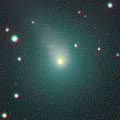
|
It brightened much faster than expected, and reached up to 10.0 mag in summer (Aug. 9, Juan Jose Gonzalez). Now it is fading, but it is bright as 12.8 ma still now (Dec. 13, Sandor Szabo). It keeps observable in good condition for a while after this.
Date(TT) R.A. (2000) Decl. Delta r Elong. m1 Best Time(A, h)
Dec. 29 8 38.22 17 24.7 1.920 2.815 150 14.0 2:09 ( 0, 72)
Jan. 5 8 20.53 15 43.8 1.919 2.865 160 14.2 1:24 ( 0, 71)
|

|
Now it is 12.2 mag (Dec. 23, Juan Jose Gonzalez). Extremely diffuse.
Date(TT) R.A. (2000) Decl. Delta r Elong. m1 Best Time(A, h)
Dec. 29 13 59.16 -21 13.3 6.626 6.237 62 14.1 5:36 (330, 28)
Jan. 5 14 2.36 -21 39.7 6.522 6.236 68 14.0 5:38 (337, 30)
|

|
Now it is bright as 14.0 mag (Nov. 15, Jakub Cerny). It keeps bright as 13-14 mag for a long time after this until 2013. It is observable in good condition in the Southern Hemisphere. It becomes observable in the extremely low sky from January to February in the Northern Hemisphere.
Date(TT) R.A. (2000) Decl. Delta r Elong. m1 Best Time(A, h)
Dec. 29 3 6.15 -50 41.5 5.930 6.065 93 14.2 20:32 ( 0, 4)
Jan. 5 3 2.17 -49 15.5 6.001 6.087 90 14.2 20:01 ( 0, 6)
|

|
Big asteroid discovered in 1906. It suddenly showed the cometary activity on Dec. 11, 2010, probably due to an impact of a small object. Now it is 11.9 mag (May 29, Marco Goiato). It has already turned to be stellar. It is not observable now.
Date(TT) R.A. (2000) Decl. Delta r Elong. m1 Best Time(A, h)
Dec. 29 20 5.92 -29 25.0 3.515 2.627 21 14.3 18:27 ( 57, -4)
Jan. 5 20 20.02 -28 50.5 3.553 2.638 18 14.3 18:32 ( 60, -7)
|
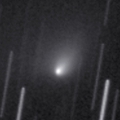
|
Now it is visible visually at 13.7 mag (Dec. 23, Juan Jose Gonzalez). It keeps 15 mag until March. In the Northern Hemisphere, it keeps observable for a long time until the comet fades out. It is not observable in the Southern Hemisphere, except for 2013 spring, but the comet locates extremely low only.
Date(TT) R.A. (2000) Decl. Delta r Elong. m1 Best Time(A, h)
Dec. 29 3 27.77 81 51.7 1.620 2.263 118 14.6 20:55 (180, 44)
Jan. 5 3 19.13 75 47.4 1.608 2.266 119 14.6 20:19 (180, 50)
|

|
Now it is 16.9 mag (Dec. 7, J. F. Hernandez). It will brighten very rapidly, and reach up to 13 mag from winter to spring. In the Northern Hemisphere, it keeps observable in excellent condition. In the Southern Hemisphere, it keeps locating extremely low for a while.
Date(TT) R.A. (2000) Decl. Delta r Elong. m1 Best Time(A, h)
Dec. 29 10 27.65 36 33.2 1.446 2.194 128 15.0 3:57 (180, 89)
Jan. 5 10 30.17 36 36.7 1.366 2.164 133 14.7 3:32 (180, 88)
|
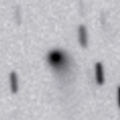
|
It is expected to keep 13 mag and observable in good condition in the Northern Hemisphere for a long time from 2013 to 2014. Now it is 15.4 mag (Nov. 19, V. Gerke, A. Novichonok, S. Plaksa). It will be observable also in the Southern Hemisphere from early December to early March, although it locates low.
Date(TT) R.A. (2000) Decl. Delta r Elong. m1 Best Time(A, h)
Dec. 29 11 31.61 25 49.7 4.261 4.732 112 14.9 5:01 ( 0, 81)
Jan. 5 11 29.40 27 32.6 4.117 4.691 120 14.8 4:31 ( 0, 82)
|

|
It brightened very rapidly and unusually, and reached up to 10 mag. It is bright as 11.3 mag still now (Dec. 8, Carlos Labordena). However, it is getting diffuse rapidly. It keeps high for a long time in the Northern Hemisphere. But the comet will be fading after this. It is not observable after this in the Southern Hemisphere. The nuclear split was observed in late October.
Date(TT) R.A. (2000) Decl. Delta r Elong. m1 Best Time(A, h)
Dec. 29 1 0.97 43 11.0 1.097 1.712 110 14.8 18:29 (180, 82)
Jan. 5 1 18.04 43 27.7 1.182 1.754 107 15.4 18:32 (164, 81)
|

|
Now it is visible visually at 14.4 mag (Nov. 15, Sandor Szabo). It keeps 15-16 mag until February. It keeps observable in good condition for a long time until the comet fades out in the Northern Hemisphere. It is not observable until 2013 summer in the Southern Hemisphere. By the way, Juan Jose Gonzalez reported it extremely bright as 10.4 mag visually on Nov. 6.
Date(TT) R.A. (2000) Decl. Delta r Elong. m1 Best Time(A, h)
Dec. 29 0 6.35 69 12.6 3.123 3.571 109 15.6 18:27 (172, 55)
Jan. 5 0 10.83 65 38.9 3.193 3.581 105 15.6 18:32 (165, 57)
|

|
First return of a new periodic comet which brightened up to 14 mag in 2005. It brightened very rapidly and became much brighter than originally expected. It is bright as 12.7 mag still now (Nov. 24, Seiichi Yoshida). It keeps high for a long time in the Northern Hemisphere. But the comet will be fading after this. It locates very low in the Southern Hemisphere.
Date(TT) R.A. (2000) Decl. Delta r Elong. m1 Best Time(A, h)
Dec. 29 2 4.88 39 53.1 1.154 1.871 121 15.6 19:33 (180, 85)
Jan. 5 2 15.89 39 27.9 1.245 1.912 117 16.0 19:16 (180, 85)
|

|
Now it is 16.0 mag (Nov. 15, Jakub Cerny). In the Southern Hemisphere, it will be observable at 15-16 mag in good condition for a long time until 2013 summer. It is not observable at all in the Northern Hemisphere.
Date(TT) R.A. (2000) Decl. Delta r Elong. m1 Best Time(A, h)
Dec. 29 22 57.52 -75 50.6 4.428 4.057 61 15.8 18:27 ( 8,-22)
Jan. 5 23 23.89 -74 31.7 4.448 4.074 61 15.8 18:32 ( 9,-21)
|
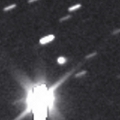
|
Now it is 16.0 mag (Dec. 10, D. Pivato). It is expected to be a great comet in 2013 autumn when the comet approaches to the sun down to only 0.01 A.U. It keeps visible with naked eyes from November to January, and can be extremely bright as Venus or more at the highlight. The condition is excellent in the Northern Hemisphere. It keeps observable almost all through the period of brightening, at the highlight, and of fading. The condition is not good in the Southern Hemisphere. It is not observable at all the latter part of the highlight, and it keeps low all through the period.
Date(TT) R.A. (2000) Decl. Delta r Elong. m1 Best Time(A, h)
Dec. 29 7 54.31 30 35.0 4.357 5.293 160 15.9 1:25 ( 0, 86)
Jan. 5 7 47.39 30 54.9 4.256 5.219 167 15.8 0:50 ( 0, 86)
|

|
Although it had been unobservable for a while, it is appearing in the morning sky now. It keeps bright as 13-14 mag for a long time from 2013 to 2014.
Date(TT) R.A. (2000) Decl. Delta r Elong. m1 Best Time(A, h)
Dec. 29 14 14.42 -8 11.8 4.028 3.695 63 16.2 5:36 (319, 37)
Jan. 5 14 20.75 -8 44.0 3.917 3.679 68 16.1 5:38 (326, 40)
|

|
It kept as bright as 11-12 mag for a long time from 2011 autumn to 2012 spring. Now it is fading. It has already faded down to 17.5 mag (Dec. 8, K. Hills). It keeps observable in good condition until 2013 spring while the comet will be fading gradually.
Date(TT) R.A. (2000) Decl. Delta r Elong. m1 Best Time(A, h)
Dec. 29 10 39.23 1 5.3 2.682 3.240 116 16.2 4:09 ( 0, 56)
Jan. 5 10 38.28 1 0.8 2.624 3.272 123 16.2 3:40 ( 0, 56)
|
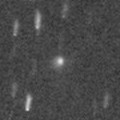
|
Now it is 16.5 mag (Dec. 8, Ken-ichi Kadota). It will brighten up to 12 mag from summer to autumn in 2013. In the Northern Hemisphere, it is observable only until 2013 spring when the comet brightens up to 15 mag. In the Southern Hemisphere, it keeps unobservable until 2013 August. Then it keeps observable while fading gradually.
Date(TT) R.A. (2000) Decl. Delta r Elong. m1 Best Time(A, h)
Dec. 29 22 36.82 59 21.9 3.035 3.294 96 16.6 18:27 (148, 56)
Jan. 5 22 51.39 57 50.6 3.014 3.224 93 16.5 18:32 (143, 55)
|
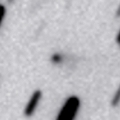
|
It was identified with an old comet discovered in 1931 by Tombaugh. It was unusually bright as 12.5 mag in 1931. Now it is 17.5 mag (Dec. 4, Mt. Lemmon Survey). It keeps 17.5 mag until March, and keeps observable in excellent condition in the Northern Hemisphere. It locates low in the Southern Hemisphere.
Date(TT) R.A. (2000) Decl. Delta r Elong. m1 Best Time(A, h)
Dec. 29 7 8.22 31 54.1 1.505 2.476 168 17.3 0:39 ( 0, 87)
Jan. 5 7 2.67 32 58.5 1.495 2.468 169 17.3 0:06 ( 0, 88)
|
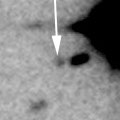
|
Now it is 17.3 mag (Nov. 10, K. Hills). In the Southern Hemisphere, it keeps observable at 17 mag in good condition for a long time from 2012 to 2013. It is not observable at all in the Northern Hemisphere.
Date(TT) R.A. (2000) Decl. Delta r Elong. m1 Best Time(A, h)
Dec. 29 3 17.53 -75 46.3 4.981 4.847 76 17.3 20:42 ( 0,-21)
Jan. 5 2 51.38 -74 55.5 5.008 4.844 74 17.4 19:49 ( 0,-20)
|
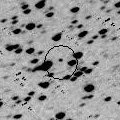
|
Peculiar asteroid moving along a cometary orbit. It keeps observable at 18 mag for a long time from 2008 to 2014. It locates extremely low in the Southern Hemisphere.
Date(TT) R.A. (2000) Decl. Delta r Elong. m1 Best Time(A, h)
Dec. 29 7 40.28 38 54.1 6.200 7.125 158 17.5 1:11 (180, 86)
Jan. 5 7 34.39 39 36.8 6.196 7.137 161 17.5 0:37 (180, 85)
|
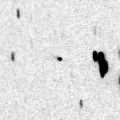
|
Although it was 18.7 mag on Oct. 18 (Siding Spring Survey), it brightened rapidly up to 17.2 mag (Dec. 4, Hidetaka Sato). It will be observable at 17.5 mag in good condition until February.
Date(TT) R.A. (2000) Decl. Delta r Elong. m1 Best Time(A, h)
Dec. 29 0 26.82 -11 59.1 1.696 1.870 83 17.6 18:27 ( 11, 43)
Jan. 5 0 33.56 -8 11.7 1.753 1.855 79 17.6 18:32 ( 21, 45)
|
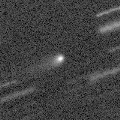
|
It brightened up to 16.5 mag in 2012. It will be observable in good condition again at 17.5 mag in 2013 spring.
Date(TT) R.A. (2000) Decl. Delta r Elong. m1 Best Time(A, h)
Dec. 29 14 22.85 1 10.4 6.192 5.851 65 17.6 5:36 (309, 44)
Jan. 5 14 22.19 1 20.3 6.086 5.865 72 17.6 5:38 (318, 48)
|

|
Now it is 19.2 mag (Dec. 17, iTelescope Observatory, Mayhill). It keeps observable in good condition at 17 mag from January to June. It locates somewhat low in the Southern Hemisphere.
Date(TT) R.A. (2000) Decl. Delta r Elong. m1 Best Time(A, h)
Dec. 29 9 27.33 14 48.7 1.428 2.257 138 17.8 2:57 ( 0, 70)
Jan. 5 9 27.32 15 13.5 1.351 2.231 145 17.6 2:30 ( 0, 70)
|
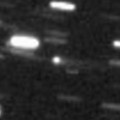
|
Now it is 17.9 mag (Nov. 1, P. Dupouy, J. B. de Vanssay). It reached up to 17 mag in last winter between 2011 and 2012. It will be observable in good condition again at 17.5 mag in this winter.
Date(TT) R.A. (2000) Decl. Delta r Elong. m1 Best Time(A, h)
Dec. 29 9 42.45 15 41.3 3.377 4.130 134 17.7 3:12 ( 0, 71)
Jan. 5 9 40.39 15 52.0 3.314 4.138 142 17.7 2:43 ( 0, 71)
|

|
It brightened up to 12 mag in 2010. Now it is 17.7 mag (Dec. 8, J. F. Soulier). Now the comet is around the aphelion. But it will be observable at 17.5 mag in good condition from autumn to winter.
Date(TT) R.A. (2000) Decl. Delta r Elong. m1 Best Time(A, h)
Dec. 29 3 56.30 20 33.1 3.865 4.694 143 17.8 21:23 ( 0, 76)
Jan. 5 3 53.31 20 31.7 3.945 4.702 135 17.8 20:52 ( 0, 76)
|

|
Now it is 17.1 mag (Dec. 2, Catalina Sky Survey). It will be observable at 17-18 mag for a long time from 2013 to 2014.
Date(TT) R.A. (2000) Decl. Delta r Elong. m1 Best Time(A, h)
Dec. 29 12 15.41 4 59.0 3.772 3.995 95 17.9 5:36 (356, 60)
Jan. 5 12 18.42 4 44.5 3.658 3.984 102 17.8 5:20 ( 0, 60)
|
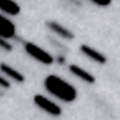
|
Now it is 17.5 mag (Nov. 10, J. Lozano). It keeps 17-18 mag for a long time until the end of 2013. The condition is good in the Northern Hemisphere. It is not observable in the Southern Hemisphere, but it will be observable in good condition after the end of 2013 May.
Date(TT) R.A. (2000) Decl. Delta r Elong. m1 Best Time(A, h)
Dec. 29 23 25.20 33 60.0 4.490 4.596 89 17.9 18:27 ( 94, 71)
Jan. 5 23 26.69 32 19.0 4.585 4.578 83 17.9 18:32 ( 93, 64)
|

|
First return of a new periodic comet discovered in 1997 at 17 mag. Now it is 18.1 mag (Nov. 14, R. Ligustri). It was expected to keep 17 mag for a long time from 2012 to 2014. But actually, it is fainter than predicted by 1-2 mag.
Date(TT) R.A. (2000) Decl. Delta r Elong. m1 Best Time(A, h)
Dec. 29 1 51.79 11 34.2 3.303 3.791 112 19.2 19:19 ( 0, 67)
Jan. 5 1 53.68 11 40.5 3.388 3.778 105 19.2 18:53 ( 0, 67)
|
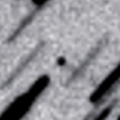
|
It was observed at 17 mag in 2011 autumn. It was expected to be observable at 17 mag in good condition again from autumn to winter in 2012. But actually, the comet is 19.9 mag (Nov. 27, Mt. Lemmon Survey), much fainter than this ephemeris. The comet must have faded out very rapidly.
Date(TT) R.A. (2000) Decl. Delta r Elong. m1 Best Time(A, h)
Dec. 29 6 14.27 39 54.7 2.303 3.256 162 20.8 23:40 (180, 85)
Jan. 5 6 7.13 40 49.9 2.346 3.280 158 21.0 23:06 (180, 84)
|
|
![]()
 244P/2010 Q1 ( Scotti )
244P/2010 Q1 ( Scotti ) 65P/Gunn
65P/Gunn P/2012 B1 ( PanSTARRS )
P/2012 B1 ( PanSTARRS ) C/2012 S4 ( PanSTARRS )
C/2012 S4 ( PanSTARRS ) 270P/2012 S5 ( Gehrels )
270P/2012 S5 ( Gehrels ) P/2011 N1 ( ASH )
P/2011 N1 ( ASH )![]()







































